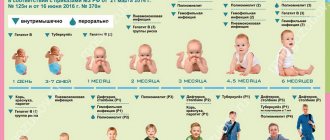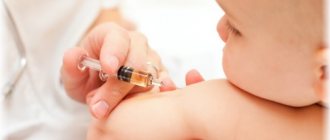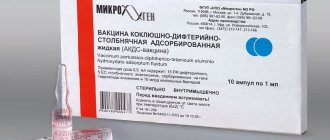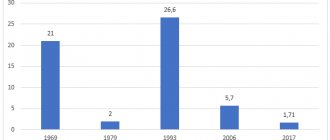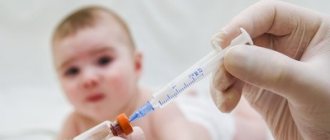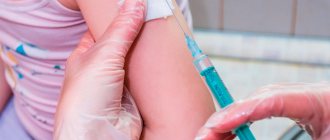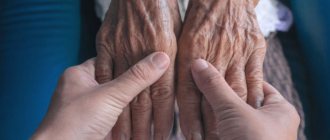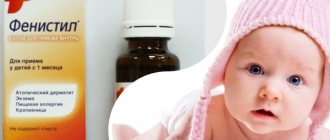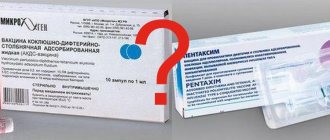What is it, what is it for, composition
Vaccination is the main preventive measure aimed at viral and infectious diseases. It suppresses the child’s fragile immunity. DPT injection is considered one of the most common. It is given to prevent whooping cough, tetanus, and diphtheria. The structure of the medicinal solution includes the following components:
- tetanus toxoid;
- pertussis microbial cells;
- diphtheria toxoid.
Vaccination is carried out at three months of age. During this period, the child is in a vulnerable state, since the immune system is not fully formed. The introduction of a drug with foreign cells into the body triggers complex mechanisms. This provokes the appearance of side symptoms. The most reactogenic substance of the drug is whooping cough cells. That is why some pharmaceutical companies exclude potentially dangerous components from the composition.
What is the DPT vaccine for: explanation and indications
The abbreviation DTP stands for adsorbed pertussis-diphtheria-tetanus vaccine. Its composition is a suspension of inactivated pertussis bacteria, as well as purified diphtheria and tetanus toxoids in various dosages.
Thus, one milliliter of the domestically produced DPT vaccine contains:
- 20 billion microbial pertussis cells;
- 30 flocculating units of diphtheria toxoid;
- 10 units of tetanus toxoid;
- as a preservative - merthiolate (thiomersal).
The indication for the use of the DPT vaccine is the simultaneous prevention of whooping cough, diphtheria and tetanus in children aged three months to three years.
The main task of such a vaccination is to stimulate the production of specific antibodies to the above-mentioned infectious diseases.
The vaccine meets all requirements of the World Health Organization.
To whom and when do they do it: indications, schedule
DTP is done for preventive purposes. It is a mandatory measure. No special indications for vaccination are required. But the following conditions must be met:
- examination by a pediatrician;
- age at least 3 months;
- normal test results;
- good health of the baby.
Parents have the right to refuse preventive manipulation without giving reasons. The DTP schedule is presented in the table. Please note that at 3 months of age this vaccine is often combined with the polio vaccine.
| Type of injection | Date |
| First vaccination | 3, 4, 5 or 6 months |
| First revaccination | 1.5 years |
| Second revaccination | 7 years |
| Third revaccination | 14 years |
In adulthood, revaccination is carried out every 10 years, starting at the age of 24 years.
Compatibility of vaccines with each other
Most vaccines have antigenic, clinical and immunological compatibility: their immediate correct use does not suppress the specific immune response and does not increase the likelihood and severity of side effects. When implementing the current vaccination calendar, two types of immunobiological preparations are used.
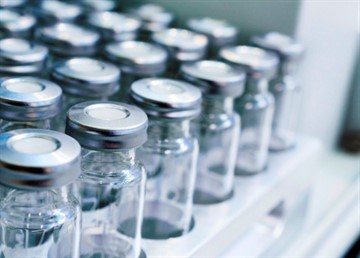
Live vaccines:
- MMR (measles-mumps-rubella);
- OPV (polio vaccine drops);
- against rotavirus infection;
- from chicken pox;
- anti-influenza (in drops).
Inactivated (killed) vaccines:
- DTP (pertussis-diphtheria-tetanus);
- IPV (injection polio vaccine);
- against pneumococcal infection;
- from hepatitis (A and B);
- anti-influenza (by injection);
- from meningococcal infection;
- against hemophilus influenzae infection.
The simultaneous administration of vaccines is practiced in accordance with the recommendations of epidemiologists and immunologists, established by the Ministry of Health of the Russian Federation.
- two or more inactivated biological products are administered simultaneously - on the same day in different syringes to different anatomical areas or on any other day;
- vaccination with two or more inactivated vaccines and one live biological product can also be carried out on the same day, distributing them into different syringes and different anatomical zones or at any other interval;
- two or more live vaccines can be used either simultaneously - on the same day, but in different syringes and in different anatomical areas, or with a time interval of at least 4-5 weeks.
The exception is the live BCG vaccine: it is compatible only with a biological product against hepatitis B; it must be performed separately from all other vaccinations and at an interval of at least a month.
Can I give the flu vaccine along with measles?
Both live and inactivated influenza vaccines are given on the same day with any vaccinations from the National Calendar, except BCG. If it is not possible to vaccinate against influenza and measles at the same time, a break of 4-5 weeks is taken between the MMR and any (live or killed) influenza vaccine.
Are DTP and measles vaccination compatible?
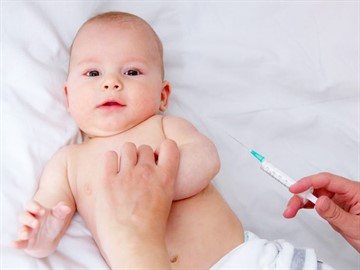
The vaccination calendar provides for complex immunization with DPT with vaccines against polio, hepatitis B, pneumococcal and hemophilus influenzae infections.
If it is necessary to restore the calendar schedule (more often when traveling abroad), the World Health Organization recommends the simultaneous administration of all immunobiological drugs indicated for a child or adult according to their age.
Clinical practice has shown that local reactions to PDA are observed somewhat more often if DTP was simultaneously introduced into another anatomical zone. However, titers of immunoglobulins that form reliable protection against infections were similar to those in children vaccinated with monovaccines.
If there were pronounced vaccine reactions in response to the previous administration of DTP, then an interval of at least 45-60 days is maintained between it and the CCP.
Is it possible to get vaccinations against hepatitis, polio and DTP together?
Immunobiological preparations for the formation of immunity to hepatitis, diphtheria, whooping cough, polio and tetanus are recommended by specialists for simultaneous administration. Antigens of the causative agents of these diseases are included in the combined six-component vaccines Infanrix Hexa and Hexaxim and are administered comprehensively in one syringe.
Preparing a child for vaccination
To make the process of administering the medicine as comfortable as possible for the child, you should properly prepare for the procedure. Among the mandatory conditions:
- It is necessary to first visit a neurologist and undergo the appropriate tests.
- If the baby has an allergic reaction, antihistamines are taken 3 days before the visit to the treatment room. Dosage and regimen are discussed individually.
- On the day of vaccination, you should not give your child heavy food.
- Before vaccination, you should make sure that the baby is in good health.
Answers to frequently asked questions
- What to do if a child has a fever after DPT vaccinations and polio? If the thermometer is below 38.0 °C, give a mild antipyretic drug - Paracetamol, Efferalgan, Panadol, Tylenol. If it exceeds 38.0 °C, then Nurofen or Ibuprofen in syrup will do. If these remedies are ineffective, you can give Nimesulide. In addition, you need to give solutions to replenish fluid in the body. To do this, dissolve Regidron, Glucosolan, Humana Elektrolyt or Gastrolit powder in water. And also drink liquids - fruit juice, lemon tea or compote.
- When can you go for a walk after DPT and polio vaccination? When you come home after vaccination, measure the temperature and examine the baby for rashes and general condition. On the day of the procedure, it is better to stay at home to monitor your baby. The very next day, take him out for a walk, but not to the playground, but to the park. A dose of oxygen will help you sleep and restore strength. You need to walk as much as possible every day.
- Is it possible to wet the area where the DPT and polio vaccine was given? Do not wet it on the first day to avoid infection. The next day you can wet it, but do not rub it.
- Is it possible to bathe a child after DPT and polio vaccination? On the first day, refrain from washing it - the wound should heal. The next day you can bathe without using a washcloth if your body temperature is not higher than 37.5 °C. At high temperatures, you can wipe the skin with a damp cloth.
- What to do if a child’s leg hurts after vaccination against DPT and polio? According to WHO recommendations, a child is vaccinated in the thigh in the first year of life. Injecting a vaccine into the buttock is considered a violation of the rules. After one and a half years, DPT is given to the shoulder. When the vaccine is injected into the thigh, the risk of complications decreases, but in some cases the baby's leg hurts greatly. Then the leg cannot be rubbed, heated or cold applied to it. Painful swelling at the injection site may resolve within 2 weeks. And this is normal, because there is an inflammatory process here, which decreases after the drug is absorbed. You can speed it up by applying Troxevasin gel. Typically, severe compaction develops if the vaccine is not injected into the muscle, but under the skin, from where absorption is slowed down. But when the injection is made with poor asepsis, suppuration may form, which is accompanied by an increase in temperature. In this case, the child should be consulted by a surgeon.
We advise you to study - Lumbodynia: code according to ICD 10
For whom vaccinations are contraindicated
Before vaccination, you must ensure that there are no contraindications. For this purpose, a medical examination is carried out. Vaccinations are strictly contraindicated in the following cases:
- immunodeficiency disorders;
- epilepsy;
- side effects that occurred due to previous vaccination;
- convulsions not accompanied by an increase in body temperature;
- progressive encephalopathy;
- neurological diseases;
- birth injuries.
There are a number of relative contraindications. If available, the decision to vaccinate is made on an individual basis. In most cases, vaccination is postponed to a later date. Temporary contraindications include:
- period of exacerbation of chronic diseases;
- indigestion;
- symptoms of infectious and viral diseases;
- elevated temperature of unknown origin.
What are the complications of DTP vaccination?
Every parent wants to know what the possible consequences of vaccination may be. Possible complications are divided into general and local. Most often, an allergic response develops. It is accompanied by an increase in temperature indicators. Normally, unpleasant symptoms disappear after 1-2 days.
Local body reactions
Local manifestations include symptoms affecting the injection site. It may hurt, rash, or itch. In some cases, swelling occurs. A reaction to the DPT vaccine can cause lumps on the skin. The diameter of the neoplasm is 10-15 cm. It rises above the skin surface and is easily palpable. These symptoms may be accompanied by fever. 3 days after the injection, discomfort and compaction should disappear. If this does not happen, you need to consult a doctor.
General reactions of the child’s body to DTP
Very often, after the DTP vaccination, the child’s health worsens. This is due to the activation of the body's defenses. General reactions to DTP vaccination are divided into groups, depending on the cause of their occurrence. These include:
- allergic response of the body;
- toxic poisoning;
- incorrect injection;
- addition of infection;
- damage to the nervous system.
After visiting the treatment room, doctors advise you to sit for a while in a medical facility. This is necessary to monitor the child’s condition. In case of dangerous complications, timely measures will be taken. Severe pathologies make themselves felt immediately. Minor complications tend to develop gradually. Common reactions to DPT include:
- If the technique for administering the solution is violated, the baby’s leg hurts. There may be lameness during movement.
- The most common symptoms that occur after DTP vaccination include increased body temperature. The child becomes lethargic and capricious. Possible loss of appetite and vomiting. Temperatures above 38.5 °C are considered critical.
- A dangerous manifestation of an allergic reaction in more severe cases is Quincke's edema. It develops within 20 minutes after the injection.
- If the injection area is not sufficiently disinfected, it may become infected. This leads to the development of local purulent inflammation.
- The nervous system reacts especially sharply to the entry of foreign cells into the body. The baby has seizures and his mood changes. These signs are due to slight swelling of the brain.
What can be the consequences after DTP vaccination in children?
It should be borne in mind that sometimes the consequences of DTP vaccination in children can be much more severe.
The reasons are different, including failure to comply with doctor’s requirements during the post-vaccination period and individual intolerance to the components of the vaccination drug. Adverse consequences are:
- restless crying that does not stop for several hours - this indicates damage to the nervous system as a result of exposure to the pertussis component;
- an increase in body temperature above +38⁰, accompanied by convulsive muscle spasms. This indicates disorders that are neurological in nature. If you ignore this symptom, there is a risk of cerebral hypoxia, so it is necessary to show the child to the doctor as quickly as possible;
- severe allergic manifestations in the form of atopic dermatitis and diathesis, accompanied by unpleasant sensations - dryness, itching and flaking of the skin, as well as the formation of wetting ulcers. In rare cases, allergic swelling of internal organs and anaphylactic shock may occur;
- cerebral encephalitis, which is a severe inflammatory disease.
General symptoms
Post-vaccination complications after DTP vaccination can manifest themselves in different ways. This depends on the initial state of the body, compliance with injection standards, and the immune response. The most common general symptoms include:
- increased body temperature;
- indigestion;
- skin rashes;
- allergies;
- cough, snot;
- convulsions.
Increased body temperature
The main thing that parents need to know is how long the temperature lasts after vaccination. It can be used to determine the degree of sensitivity of the body to the introduced drug. If the temperature stays around 37.5 °C, we are talking about a weak reaction of the body. The average degree of intensity of complications is indicated by a temperature in the range from 37.5 to 38.5 °C. Anything higher is considered a severe deviation requiring medical intervention.
Intestinal disorders
After vaccination with DTP, difficulties may arise with the digestion process. Dyspeptic disorders often appear, accompanied by loss of appetite and nausea. A short-term but fairly common side effect is diarrhea. It is typical not only for tetanus vaccination, but also for polio vaccination. In this case, vaccination is carried out with medicine in liquid form. Typically, digestion returns to normal within 2-3 days after the vaccine is administered.
Rash all over the body
Possible adverse reactions from vaccination include rashes. They can be localized in a specific area or scattered throughout the body. Most often, the rash appears in the form of small dots. It develops as a result of an allergic reaction or is a consequence of a decrease in the body's defenses.
In the second case, the rash indicates the appearance of chickenpox. One of the reasons for its development is suppressed immunity. The rash may itch and crust over. The child during this period is a carrier of the disease. Therefore, you need to limit contact with others.
Allergic rash
After receiving a tetanus shot, there is an increased risk of developing an allergic reaction. Most often it manifests itself in the form of a characteristic rash. Red dots on the body may be accompanied by swelling of the skin surface and itching sensations. Allergic manifestations make themselves felt in the first hours after vaccination. If your baby experiences asthma attacks, immediate help should be provided.
Cough and snot
Against the background of vaccination, symptoms of whooping cough appear in children. This is due to the insignificant introduction of bacterial cells into the body. Common side effects include mucous discharge from the nose and intense cough. With whooping cough, the respiratory system is primarily affected. A child's body may not be able to withstand the load on the lungs. After the vaccine is administered, the cough is not as intense. As a rule, it completely disappears after 2-3 days.
Convulsions
Seizures are considered the initial stage of the development of post-vaccination encephalitis. It is characterized by inflammation in the brain area. According to medical statistics, seizures develop very rarely. In 95% of cases they occur on the first day. In some cases, their appearance is caused by an exacerbation of a hidden neurological disease. Febrile seizures are the main manifestation of a febrile state. They are often accompanied by an increase in body temperature.
What happens if you get vaccinated against whooping cough, diphtheria and tetanus at the wrong time?
If you are lucky and the child does not encounter an infection, then nothing dangerous to his life and health will happen.
Otherwise, there is a high probability that the baby will become infected even after minor contact with a carrier of the infection. The most dangerous thing for health is skipping primary vaccination.
In this case, immunity that has not yet been fully formed may not be able to cope with the impact of the infectious agent. If we are talking about revaccination, a violation of the timing (insignificant) of administering the injection is allowed.
Treatment of adverse reactions
Parents should know not only what complications DPT causes, but also how to treat them. Help for your baby after vaccination in case of side effects is as follows:
- Symptoms of an allergic reaction can be treated with antihistamines.
- The temperature should not be reduced to 38.5 °C. If it increases above this mark, it is necessary to give the child an antipyretic drug.
- If the injection area is swollen and painful, a numbing ointment is applied.
- If a lump or lump forms, accompanied by severe pain, it is necessary to show the child to a pediatrician as soon as possible.
What to do if complications arise
When vaccinated with any vaccine, including DTP, careful monitoring of the child’s condition on the day of vaccination and several days after is necessary. If side effects occur, you must immediately take adequate measures to help alleviate their course.
So, if the temperature rises, you should immediately give the child an antipyretic drug (paracetamol or ibuprofen), you can do this immediately after the vaccination and give a prophylactic dose at night. At the first symptoms of an allergy, antihistamines (anti-allergic) drugs will help; you can often apply them topically to the injection area (there are similar products in the form of ointments).

You should limit physical activity for a couple of days; drinking plenty of fluids and eating light food will be an advantage. Monitor the air and humidity parameters in the nursery: the air should be cool (18-20 degrees Celsius) and humid (60-70%). Such simple measures will help your baby endure unpleasant consequences as easily as possible.
As mentioned above, for any other reactions, for more severe complications, you must urgently go to the hospital.
Efficiency and assistance to the baby after vaccination
DPT vaccination does not provide a 100% guarantee of protection against infection. Vaccination helps to transfer the disease without complications in the event of a collision with its pathogens. The main function of vaccinations is to create collective immunity, which reduces the risk of epidemics. After revaccination, the body's resistance increases significantly.
After the injection, parents are advised to pay close attention to the baby’s well-being. The further outcome depends on how timely undesirable symptoms are detected.
Can you get whooping cough after vaccination?
The DTP vaccine contains inactivated particles of pathogenic bacteria that have undergone additional purification. Thanks to this, the introduction of a vaccine composition into the body contributes to the appearance of the correct immune response to the pathogen. However, the strength of the inactivated particles is not enough to cause the development of whooping cough.
Parents of a child undergoing immunization should not be afraid of infection.
Tips for dealing with negative reactions
It is impossible to completely protect your baby from complications that arise after vaccination against tetanus, diphtheria and whooping cough. It is quite possible to minimize risks. To do this, you must follow the following recommendations:
- You cannot bathe your child or get the injection site wet on the first day after visiting the treatment room.
- It is not advisable to visit crowded places in the first 2-3 days after vaccination.
- It is necessary to ensure a calm emotional environment in the home.
- If the baby has a negative reaction to the first vaccination, an alternative drug replacement is selected.
- During the vaccination period, the child’s diet should not be changed.
What analogues of DPT are there?
DPT is often replaced with alternative means. The following vaccine analogues are distinguished:
- Infanrix is distinguished by the absence of microorganisms that cause whooping cough in its composition. Side effects with these drugs occur less frequently. The birthplace of production is France.
- Pentaxim includes five active components. Unlike standard DPT, it provides protection against Haemophilus influenzae. The drug is produced in Belgium.
- Infanrix IPV additionally prevents a child from contracting polio.
Can vaccinations be done at the same time?
DTP (the international name for the DTP vaccine) is administered to protect the child from tetanus, diphtheria and whooping cough. These are contagious diseases, so children often become infected with them, but they are difficult to tolerate. Poliomyelitis often leads to the development of complications such as paralysis of the limbs. Vaccination against such diseases is included in the national vaccination calendar. In Russia, the timing of immunization against polio and DTP coincides, so they are often carried out simultaneously.
Many parents are interested in whether such vaccinations can be done at the same time, whether such a combination will be dangerous for the baby. Side effects from the joint administration of the DTP vaccine and polio occur no more often than after separate immunization. If the child has been properly prepared for vaccination, the risk of developing negative consequences is greatly reduced.
The DTP drug is used only until the age of four, and then an imported vaccine called Infanrix is used. At the same time, live oral polio OPV or inactivated polio vaccine is administered.
We advise you to study - Cervical spine block: reviews
The first vaccination is given when the child is about three months old. The second is carried out at 4.5 months. The third immunization is carried out at six months. Revaccination is done one year after the last vaccination.
Contraindications
Before immunizing a child, he should be carefully examined by a pediatrician. Only after this the doctor gives a referral for vaccination. There are temporary contraindications to vaccination. These include:
- exacerbation of colds;
- rehabilitation period after illness.
Due to intolerance to the components of the drug, it is necessary to replace the vaccine with a lighter formula or an analogue. For example, the pertussis component is removed from DPT, and an inactivated one is used instead of a live polio vaccine.
Absolute contraindications to DPT and polio vaccinations:
- severe neurological diseases;
- complicated immunodeficiency;
- severe allergic reactions to the vaccine;
- complications after previous immunization.
- https://momjournal.ru/zdorove-rebenka/privivki/akds-i-poliomielit-odnovremenno.html
- https://vactsina.com/privivki-i-ukolyi/akds-i-poliomelit-odnovremenno.html
- https://spina-expert.ru/lechenie/akds-i-poliomielit-odnovremenno/
- https://ukol.expert/privivki/akds-i-poliomelit-odnovremenno
- https://privivku.ru/detyam/akds-i-poliomelit-odnovremenno.html
- https://privivkumne.ru/detyam/akds-i-poliomielit-odnovremenno.html
- https://deti-zdorovy.ru/privivki/akds-i-poliomielit-odnovremenno/
In what cases do they call the ambulance?
Serious complications can occur after vaccination against diphtheria, whooping cough and tetanus. But not in all cases, parents are able to distinguish standard side effects from severe complications. The emergency room is called if the following signs are present:
- Quincke's edema;
- drop in blood pressure;
- critical increase in body temperature (from 40 °C);
- swelling at the injection site, the diameter of which exceeds 10 cm;
- crying for more than 3 hours.
If you have doubts about a particular symptom, it is recommended to consult a pediatrician. There is no need to be too vigilant in this case. The effectiveness of treatment of complications directly depends on the timeliness of their detection.
DTP vaccine (pertussis-diphtheria-tetanus toxoid)
This vaccination is a preventive measure for severe forms of whooping cough, diphtheria and tetanus. These are extremely dangerous diseases and the mortality rate from them is quite high.
- Diphtheria is an acute infectious disease that affects the upper respiratory tract. Such an infection causes intoxication and causes pathology of the nervous, cardiovascular system, and kidneys. The method of transmission is airborne. In the middle of the last century, diphtheria was practically defeated, but the abolition of compulsory vaccination caused new outbreaks of infection.
- Tetanus affects the nervous system. In severe cases, it leads to respiratory and cardiac arrest. This infection enters the human body through wounds and cuts made from soil, dirt and sand. Tetanus outbreaks tend to occur in disaster and emergency areas. At high risk are children who are prone to injury under any circumstances.
- Whooping cough is an infectious disease accompanied by a prolonged cough. The method of transmission is airborne. Very dangerous at an early age, it can cause respiratory arrest. The transferred disease does not form immunity, but only facilitates the course of re-infection.
According to the accepted vaccination calendar, DPT vaccination is carried out in four stages.
DPT is administered intramuscularly by injection. The vaccination schedule strictly corresponds to the child’s age and looks like this:
- two - three months;
- four to five months;
- six months;
- one year and six months.
This complex of four DPT vaccinations reliably protects the body from diseases. Subsequently, revaccination is carried out (repeated vaccination, which maintains immunity at the required level of activity). It is done at the ages of 7 and 14 years, then every decade.
We advise you to study - Left-sided scoliosis
Contraindications
There are contraindications for DPT. These include reasons that exclude any vaccination: acute respiratory infections and the recovery period, an allergic reaction to vaccine components, severe immunodeficiency. Also, DTP vaccination cannot be carried out in case of progressive pathology of the nervous system or convulsions. In such cases, the pertussis component is excluded from the vaccine.
Side effects after DTP
The occurrence of mild adverse reactions is a positive sign that indicates the correct formation of immunity. At the same time, the absence of such phenomena does not mean violations and defects in the formation of immunity. Redness and swelling may occur at the site where the DTP vaccine was administered.
The DTP vaccine can affect the general condition of the baby as follows:
- temperature increase;
- vomit;
- diarrhea;
- lack of appetite;
- restless behavior;
- lethargy and drowsiness.
Complications after DTP
When the vaccine is administered, allergic reactions from simple urticaria to anaphylactic shock are possible. Complications can be caused by: improper preparation for vaccination, the amount of ballast substances in the administered drug, as well as the individual characteristics of the body.
